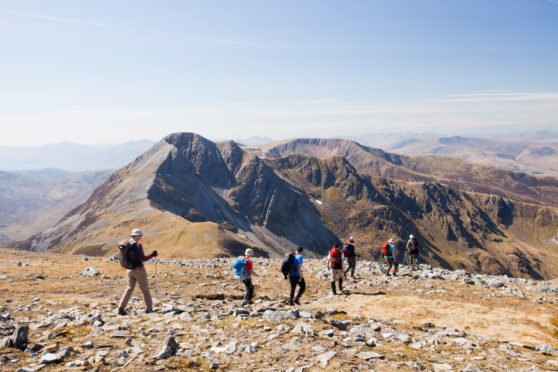
A massive lump of a mountain that rises from the valley floor to form the southern wall of Glen Nevis, Sgurr a’ Mhaim dominates the western view of the Mamores when approached from Fort William.
It can be climbed as a single Munro from Polldubh – either as a “there-and-back”, or more preferably as a circuit, taking in the wonderful “Devil’s Ridge” arête that links the hill to the main Mamores ridge.
It’s not how I’d recommend climbing the hill, though. The ascent is unrelentingly steep. Sure, it gets you there quick – but I’d struggle to describe it as “pleasant”.
And as a single, even including the Devil’s Ridge, you’re missing out on one of the finest mountain walks in all Scotland – a true classic, The Ring of Steall.
There are 10 Munros on the Mamores ridge. They can all be done in a day – a very long, tiring but incredibly rewarding day. I walked it a couple of years ago with Iain Cameron, the man who records Scotland’s snow patches. It was a 26-mile route with around 9,843ft of ascent and took 12 hours.
Most will opt to break the ridge into chunks, and the hills are nicely grouped for this. From the east, they neatly fall into sets of four, four and two Munros. The middle four are known as The Ring of Steall.
It’s a fabulous day out – a thrilling mountain adventure, and one to savour in good conditions.
It includes a walk through a stunning gorge, a river crossing on a wire bridge, excellent stalkers’ paths, fine, airy ridge walking, fun scrambling and views of some of the country’s most famous mountains – including the Grey Corries, the Aonachs and Ben Nevis. Oh, and you pass beneath the second-highest waterfall in Scotland.
Guide to Sgurr A’Mhaim
Pronunciation: S-goo-r a Vime
Meaning: peak of the rounded hill
Height: 3,606ft Rank: 51
OS Landranger Map 41
Summit grid ref: NN164667 (cairn on rock)
Nearest town: Fort William is six miles north-west. Known as Scotland’s outdoor capital, the large Highland town is home to 11,000 people and well-served by public transport. It has supermarkets, gear shops and lots of food, drink and accommodation options.
The route
Start grid ref: NN168691
Distance: 10 miles
Ascent: 5,577ft
Time: 8hrs
The route starts at the road end down Glen Nevis, where there’s ample parking. It takes in four Munros, An Gearanach, Stob Coire a’ Chairn, Am Bodach and Sgurr a’ Mhaim.
If a group of you plan this route then having two vehicles would be a bonus – one can be left at Polldubh, to where you descend. It saves a trudge at the end of the day.
The walk through the fabulous Nevis Gorge opens out to a grassy, almost Alpine meadow that kind of takes you by surprise. Cross the river via the wire bridge.
From here rocky ground beneath the falls is traversed, then a boggy section to pick up the excellent stalkers’ path up the day’s first Munro, An Gearanach. From the summit, the way is obvious – the marvellous ridge.
After Am Bodach is another peak – Sgor an Iubhair. Shortly after traversing it, the Devil’s Ridge runs north to Sgurr a’ Mhaim. It’s a narrow arête, rocky and exposed in places.
The descent to Polldubh from the last Munro is down its north-west ridge – it’s brutally steep. A real knee-buster.
Hollows and boulders are testament to turbulent past
One of the highlights of the Ring of Steall comes before you even leave the valley floor – the walk through Nevis Gorge.
The 0.6-mile gorge starts immediately after leaving the car park. The river twists and turns down the very narrow gorge in a series of foaming cascades, with deep turbulent pools after every drop.
The gorge is littered with enormous boulders. Its precipitous walls are pockmarked by great scooped hollows, gouged over centuries by stones and gravel driven by furious waters. Many of the hollows lie surprisingly high on the walls – testament to how deep the river ran in times of spate. More than once I’ve heard mountaineer Cameron McNeish describe the area as “Himalayan in character, if not scale”.
The slopes above are covered in lovely native woods – Scots pine, oak, birch and mountain ash.

Enjoy the convenience of having The Sunday Post delivered as a digital ePaper straight to your smartphone, tablet or computer.
Subscribe for only £5.49 a month and enjoy all the benefits of the printed paper as a digital replica.
Subscribe